Union Budget 2024-2025
Introduction
The Union Budget 2024-25 has just been made available to the Parliament. It was the 18th Lok Sabha’s first general budget.
What are the Major Highlights of the Union Budget 2024-25?
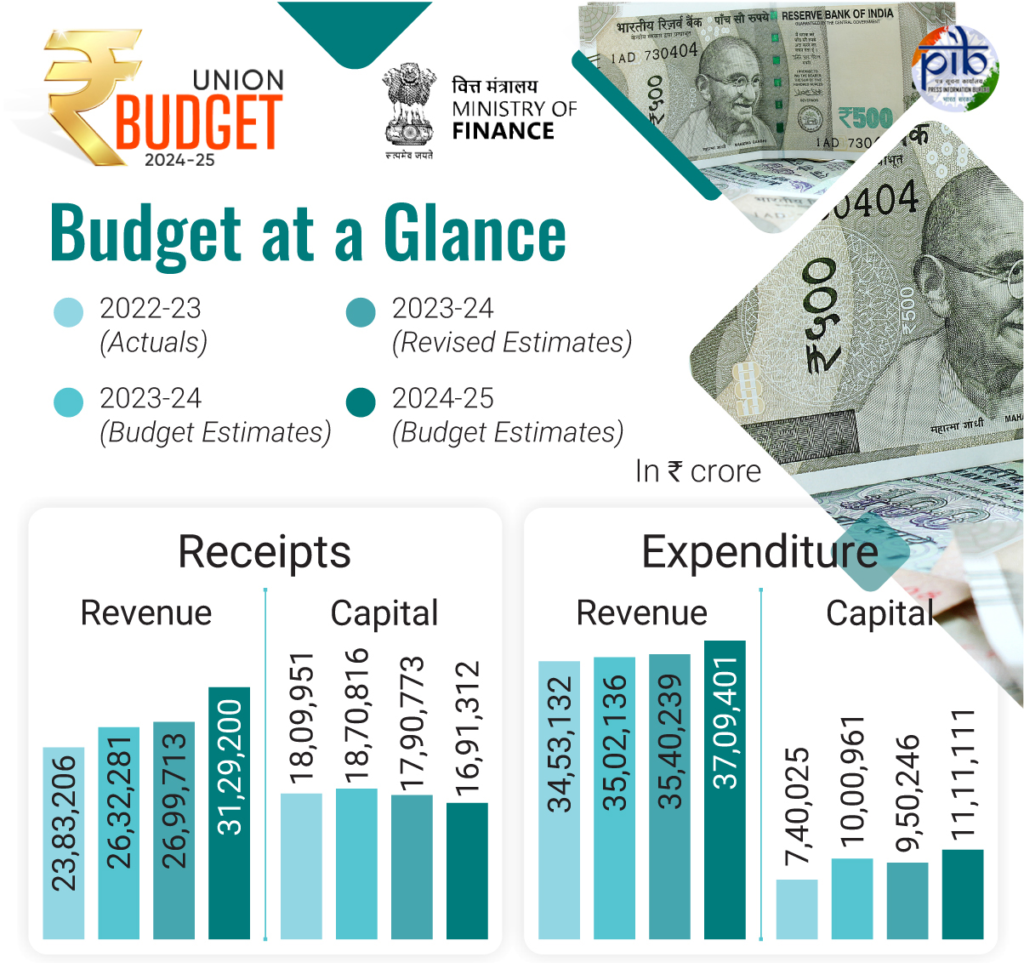
- Focus Area
- The four primary categories that the budget continues to prioritize are ‘Garib’ (the poor), ‘Mahilayen’ (the women), ‘Yuva’ (the youth), and ‘Annadata’ (the farmers), as stated in the Interim Budget.
- Budget Theme
- The middle class, employment, skill development, and assistance for MSMEs are prioritized in the Union Budget 2024-25. A significant sum of Rs 1.48 lakh crore is planned for instruction, work, and skilling.
- Budget Priorities
- Nine areas—agriculture, employment, HRD, manufacturing, services, urban development, energy security, infrastructure, innovation, R&D, and next-generation reforms—are prioritized in the budget.
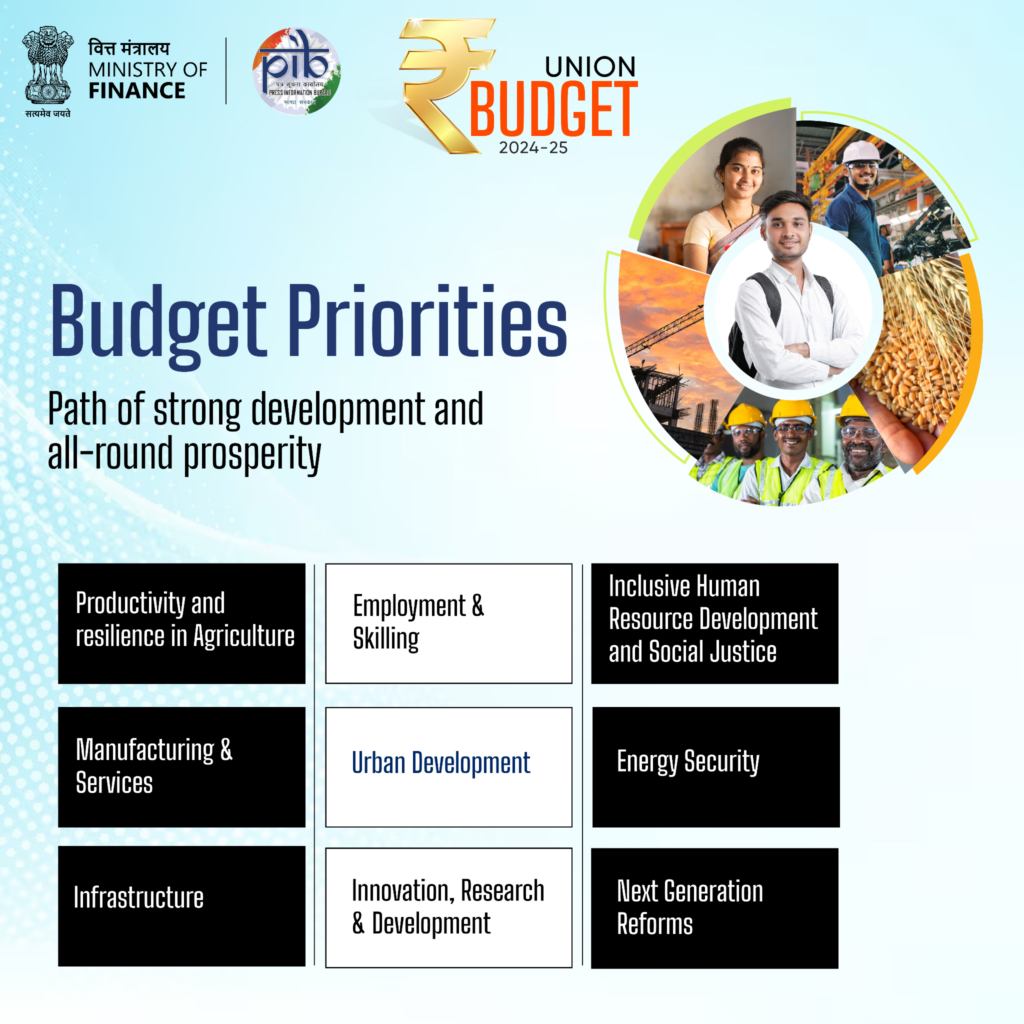
- Priority 1: Productivity and Resilience in Agriculture
- The implementation of 109 novel crop varieties with high yields, the encouragement of natural farming among one crore farmers, the establishment of 10,000 bio-input centers depending on need, and the improvement of pulse and oilseed production, storage, and marketing (achieving “atmanirbharta” for oil seeds are among the measures.
- This year, a budget of Rs 1.52 lakh crore has been set out for the agricultural and related industries.
- In three years, the government and the states will collaborate to support the agricultural sector in implementing the Digital Public Infrastructure (DPI), encompassing farmers and their holdings.
- Priority 2: Employment & Skilling
- To improve 1,000 industrial training institutes and the skills of 20 lakh youth over five years, the budget offers programs like the Employment Linked Incentive.
- It is anticipated that the revamped Model Skill Loan Scheme will assist 25,000 students annually by allowing loans up to Rs 7.5 lakh with a guarantee from a government-promoted fund.
- Priority 3: Inclusive Human Resource Development and Social Justice
- It is stressed that marginalized groups, such as women entrepreneurs and tribal tribes, need more assistance for their economic endeavors.
- With an emphasis on infrastructure development, economic growth, and the development of human resources, the government’s Purvodaya project seeks to develop the eastern region of India, which includes Bihar, Jharkhand, West Bengal, Odisha, and Andhra Pradesh, in its whole to move the area closer to being a developed nation.
- The Pradhan Mantri Janjatiya Unnat Gram Abhiyan, which would benefit almost 5 crore tribal people, was launched by the Finance Minister as a way to improve the socioeconomic status of tribal groups. It will encompass 63,000 villages in districts with a tribal majority and aspirational areas.
- This year, India Post Payment Bank will open more than 100 branches in the Northeast to improve banking services. Also, the range will get an assignment of Rs 2.66 lakh crore for framework and provincial improvement.
- Priority 4: Manufacturing & Services
- With an emphasis on labor-intensive manufacturing, the budget places a strong emphasis on supporting MSMEs. One new self-financing guarantee fund offers up to Rs 100 crore to each applicant.
- Public sector banks will improve their in-house MSME credit assessment skills. Furthermore, Mudra loan limits for former “Tarun” category borrowers would rise to Rs 20 lakh.
- Initiatives like building 50 food irradiation units, 100 food quality labs, and E-Commerce Export Hubs are also included in the budget.
- Moreover, a five-year plan offering internships in 500 of the best firms hopes to assist one crore young people.
- Priority 5: Urban Development
- One million urban poor and middle-class households will have their housing requirements met by the PM Awas Yojana Urban 2.0, which has been given Rs 10 lakh crore in funding and Rs 2.2 lakh crore in central support over five years.
- Additionally, through bankable projects, the government will work with State Governments and Multilateral Development Banks to support solid waste management, sewage treatment, and water delivery in 100 major cities.
- Moreover, the government extraordinary to made 100 week-by-week road nourishment center points (haats) annually over the following five a long time, based on the victory of PM SVANidhi.
- Priority 6: Energy Security
- The goal of the PM Surya Ghar Muft Bijli Yojana is to build rooftop solar plants so that 1 crore homes can receive free power (up to 300 units every month).
- India’s energy mix includes a sizable amount of nuclear energy.
- Priority 7: Infrastructure
- Over the next five years, the government will make an effort to continue providing significant financial support for infrastructure. This year, Rs 11,11,111 crore, or 3.4% of our GDP, has been set aside for capital expenditures.
- Due to the population increase, the Pradhan Mantri Gram Sadak Yojana (PMGSY) has launched Phase IV, which aims to connect 25,000 rural habitations with all-weather roads.
- The government of Bihar would get Rs 11,500 crore for projects like the Kosi-Mechi intra-state connection and 20 other initiatives, including barrages, river pollution abatement, and irrigation, under the Accelerated Irrigation Benefit Programme and other sources.
- Furthermore, Assam, Himachal Pradesh, Uttarakhand, and Sikkim will get financial support for initiatives linked to landslides, flood control, and other relevant areas.
- Priority 8: Innovation, Research & Development
- With an allocation of Rs 1 lakh crore, the government would create the Anusandhan National Research Fund to promote fundamental research and prototype development at the commercial scale, led by the private sector.
- To grow the space economy five times over the next ten years, a Rs 1,000 crore venture capital fund would be created.
- Priority 9: Next Generation Reforms
- To promote economic growth, plans are presented for an Economic Policy Framework, labor reforms, and the streamlining of FDI laws.
- Jan Vishwas To enhance the Ease of Doing Business, the government will present Bill 2.0.
- Other Highlights
- Economic Policy Framework
- To direct economic growth and changes aimed at improving employment, the government will create an Economic Policy Framework.
- Labor-related reforms
- Redesigned integrated portals, such as the e-shram, Shram Suvidha, and Samadhan portals, would facilitate the implementation of comprehensive labor reforms and make trade and industry compliance easier.
- To increase the amount of money available for climate adaptation and mitigation, the government will create a taxonomy for climate funding.
- Foreign Direct Investment and Overseas Investment
- To empower chances for utilizing the Indian Rupee as cash for abroad ventures, empower prioritization, and ease outside coordinate speculations, the laws and directions relating to remote coordinate ventures and abroad ventures would be streamlined.
- NPS Vatsalya
- A plan that allows minors’ parents and guardians to contribute and that plan may be easily turned into a regular NPS account once the child reaches majority.
- New Pension Scheme (NPS)
- To safeguard the general public, a committee to examine the NPS has been established to address pertinent concerns while upholding economic responsibility.
- Direct Tax Reforms
- It is suggested to thoroughly evaluate and simplify the direct and indirect tax systems.
- Revisions to capital gains taxes, tax compliance simplification, and income tax slabs and deductions are among the changes.
- Custom Duty Reforms
- The highlights include the rationalization of the rates for customs and GST, exemptions for vital minerals and medications, and initiatives to support home production.
- Dispute Resolution
- Tax certainty and lawsuit reduction are the goals of programs like the Vivad se Vishwas Scheme, higher appeals’ monetary limitations, and steps to expedite transfer pricing assessments.
- Economic Policy Framework
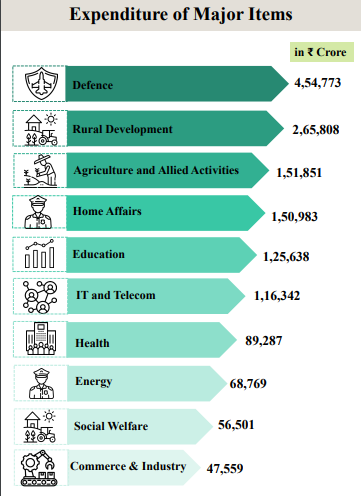
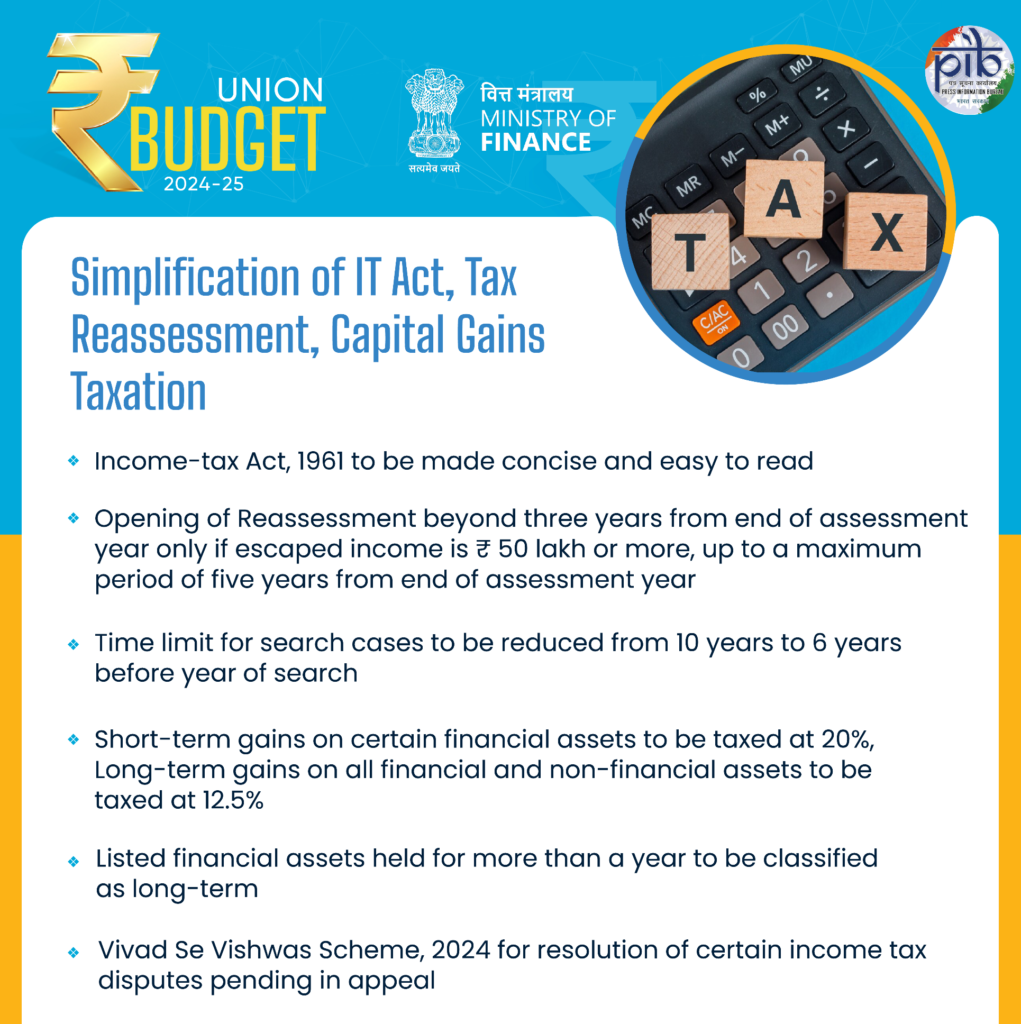
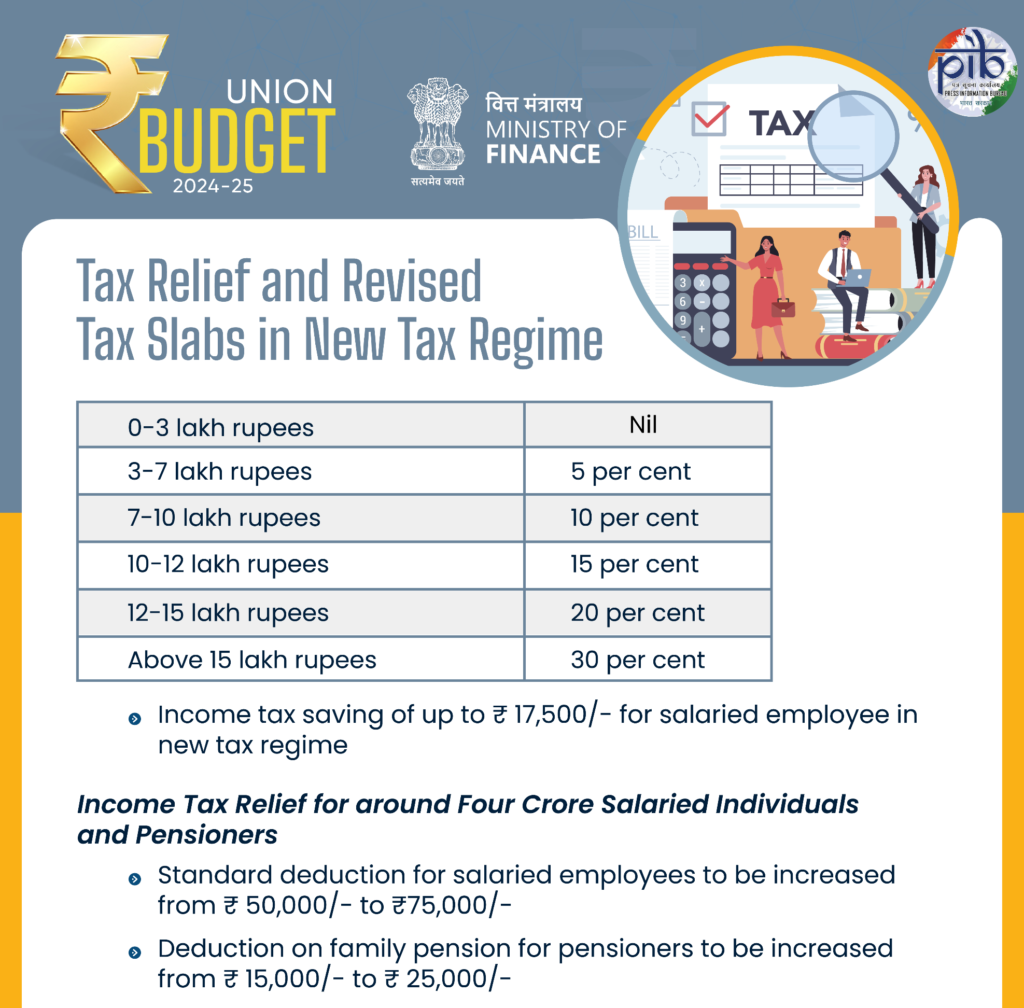
Union Budget 2024-25 Estimates
- The expected total receipts (excluding borrowings) and total expenditures for the fiscal year 2024–25 are Rs 32.07 lakh crore and Rs 48.21 lakh crore, respectively.
- Estimates have a budget deficit of 4.9% of GDP, while net tax revenues at Rs 25.83 lakh crore. The administration also plans to strive for a deficit of less than 4.5% in the upcoming year.
- It is predicted that during 2024–25, the gross and net market borrowings through dated securities will be Rs 14.01 lakh crore and Rs 11.63 lakh crore, respectively.
- India’s low and steady inflation, which is heading towards the 4% objective, was underlined in the budget address, along with special steps to guarantee a sufficient supply of perishable products.
Conclusion
The Union Budget 2024-25 emphasizes inclusive growth and economic resilience with a focus on agriculture, employment, human resource development, and infrastructure. Prioritizing the middle class, MSMEs, and skill development, it allocates significant funds for education, skilling, and innovation. Key initiatives aim to enhance productivity, support marginalized groups, and advance urban and energy development, paving the way for sustained economic progress.
Frequently Asked Questions(FAQs)
What is the budget for 2024-2025?
According to the Finance Minister, the expected total spending for 2024–25 and the total earnings (excluding borrowings) are ₹48.21 lakh crore and ₹32.07 lakh crore, respectively. It is anticipated that net assess collections will sum to ₹25.83 lakh crore, whereas the financial shortage will sum to 4.9% of GDP.
Is there any change in the tax slab in 2024?
The standard deduction for salaried staff members was raised to ₹75,000 from ₹50,000. The ₹5 lakh tax rate slab was renamed as ₹7 lakh tax rate slab.
What is the theme of Budget 2024?
Union Budget 2024-2025: Agreeing with Sitharaman, the Center has distinguished nine essential objectives relating to the foundation, vitality security, and business, among other regions, in arrange to forward the objective of “Viksit Bharat.” FM Sitharaman reaffirmed that the Modi government’s four essential need bunches are the underprivileged, ladies, ranchers, and youthful individuals.
From when is the new budget applicable?
The employer’s NPS account contribution deduction is now allowed for 14% of the total, up from 10% previously. The new tax regime’s income tax slabs will go into effect on April 1, 2024, following the budget’s passage by Parliament and approval by the president.
Sources:
- https://pib.gov.in/PressReleaseIframePage.aspx?PRID=2035618
- https://www.indiabudget.gov.in/doc/budget_speech.pdf
- https://economictimes.indiatimes.com/wealth/tax/new-income-tax-slabs-announced-in-new-tax-regime-in-budget-2024/articleshow/111522747.cms?from=mdr
- https://www.thehindu.com/business/budget/budget-2024-live-updates-nirmala-sitharaman-union-budget-highlights/article68433121.ece
- https://www.indiatoday.in/business/budget/story/union-budget-2024-what-to-expect-from-government-income-tax-support-for-rural-areas-job-creation-2569103-2024-07-19
- https://www.hindustantimes.com/budget/which-country-receives-the-most-aid-from-india-union-budget-reveals-top-10-beneficiaries-101721721610119.html
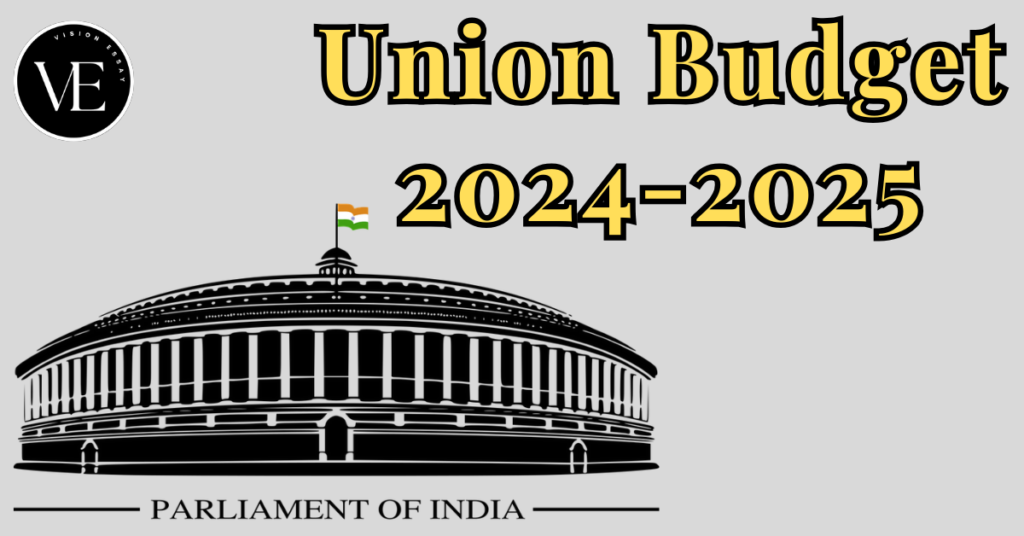
Leave a Reply